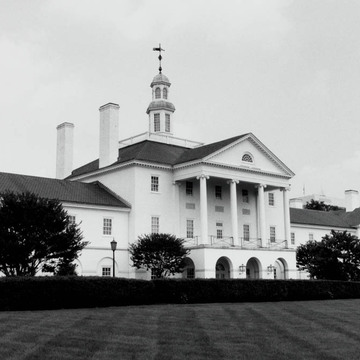Amid the sleek and soaring glass and metal high rises of downtown Richmond, the Palladian and pristine Ethyl building so commands the area once known as Gamble's Hill that many visitors to Richmond mistake it for the Virginia Capitol. Ironically, the corporation specializes in high technology and chemicals. At the request of Floyd T. Gottwald, founder of the Ethyl Corporation, the architects looked closely at the Williamsburg Inn in Colonial Williamsburg as a design source. The entrance portico, an arcade that carries a colonnade of Ionic columns, has multiple sources, but for Virginians it recalls Pavilion VII at the University of Virginia. In 1985 Carneal and Johnston added a new cupola, inspired by the doubletiered cupola on the Governor's Palace in Williamsburg. The 1989 pavilion addition included a conference center and fitness complex. It maintains the scale and “classicism” of the original building while incorporating decidedly postmodern features such as a stylized broken pediment on the riverfront side. During the course of forty years Ethyl has leveled most of the surrounding Gamble's Hill neighborhood, eliminating many historic structures to create a grassy, corporate parklike setting. Any of the fine old homes that remained were torn down in the early 1970s for the Downtown Expressway. In addition, several landmarks, including Pratt's Castle (a Gothic Revival residence), the Virginia State Penitentiary (with foundations from an eighteenth-century prison designed by Benjamin Henry Latrobe), a Depression-era reinforced concrete bridge constructed by the Works Progress Administration, and the triangular Binswanger Building, have been demolished.
You are here
Ethyl Corporation Corporate Office Building
1954–1956, 1985, Carneal and Johnston. 1989, pavilion addition, Vincent Kling and Associates. 330 S. 4th St.
If SAH Archipedia has been useful to you, please consider supporting it.
SAH Archipedia tells the story of the United States through its buildings, landscapes, and cities. This freely available resource empowers the public with authoritative knowledge that deepens their understanding and appreciation of the built environment. But the Society of Architectural Historians, which created SAH Archipedia with University of Virginia Press, needs your support to maintain the high-caliber research, writing, photography, cartography, editing, design, and programming that make SAH Archipedia a trusted online resource available to all who value the history of place, heritage tourism, and learning.

